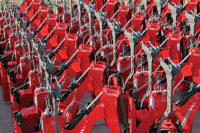TOKYO—Japan will face a labor shortage next year when new overtime regulations for truck drivers come into force. This is being called the “2024 problem,” and the country’s manufacturers are hoping robots and automation can alleviate the issue.
“The government’s overtime cap is an important step to improve working conditions for employees,” says Takayuki Ito, vice president of the International Federation of Robotics. “Industrial and service robots deliver great solutions to automate. Robots relieve workers of dirty, dull and dangerous work and help to close productivity gaps.”
In Japan, the average annual working hours for a truck driver were 2,568, which is 444 hours longer than the national average for all jobs, according to the latest data from the country’s Labor Ministry.
Placing cargo in and out of trucks and warehouses is one of the most time-consuming tasks of truck drivers. Autonomous mobile robots for transportation and logistics could help. Freeing up truck drivers from loading and unloading cargo would save up to 25 percent of their working time during a day’s shift. Robots also help reduce errors in order fulfillment by automating repetitive tasks such as picking and packing.
Warehouse robots range from compact autonomous mobile robots to large-scale automated storage and retrieval systems. Their use reduces the amount of time required to move goods, and they can handle heavy loads and dangerous materials without putting human workers at risk.
The benefits of robots for transportation and logistics are documented by latest statistics: on a global scale, more professional service robots were built for the transportation of goods or cargo than for any other function. Sales grew by 44 percent, with more than 86,000 units sold in 2022 worldwide, IFR reports.
“Regulations of overtime work and the demographic change will require the adoption of automation technology in many branches of the Japanese economy,” says Ito, who is also senior managing officer for the robotics business unit of Fanuc Corp. “The challenges of the trucking industry are good examples to show how robotics and automation deliver adequate solutions for our workplaces of the future.”

